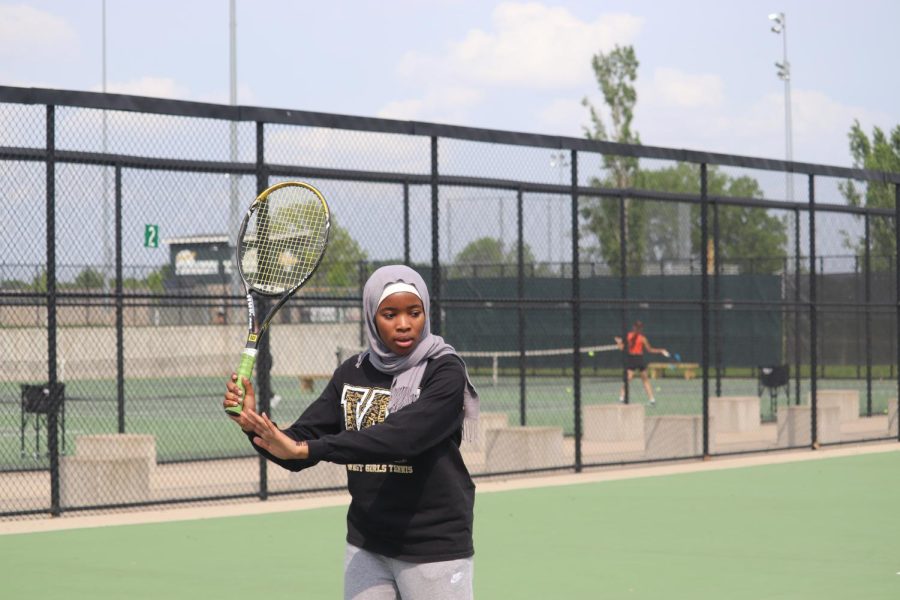Wrapped up
Unwrapping the journey of wearing a head covering in West High Athletics.
Wesal Haroun ’24 returns the ball during practice.
“It’s game day and I step onto that soccer field, and the only thing on my mind is that I have to show everyone how good I am. How great I can play, and prove to them that I am a real athlete. Because whenever I am on that field, I am representing Muslim women, so it is my job to prove that I can do just as well as others and even better,” Abeer Guama ‘26 expresses.
Two Hijabi athletes at West High were interviewed and discussed the journey of wearing a hijab as an athlete, and the ups and downs that come with it. Abeer Guama ‘26 and Wesal Haroun ‘24 have a lot to say on this matter and how their journey of being a Hijabi athlete has taught them a lot about the real world and themselves.
So what is a hijab, and why do Muslim women wear it? Well, a hijab is a head covering that is worn by Muslim women. It comes in various shapes and forms, but it is often specifically referred to as a headscarf that covers the hair, neck and ears, leaving the face visible. Muslim women wear the hijab because, for one, it is an obligation to wear one after reaching the age of puberty. It is also supposed to be worn to allow women to retain their modesty, morals and freedom of choice. The hijab also acts as a signal to let people know that they are Muslim. In the end, though, wearing the hijab comes down to the individual and their own choice.
In recent years there has been an up-rise of Hijabis in sports. This is due to the fact that there has been more Hijabi-friendly apparel made available, including things like sports hijabs that stay on your head even with a lot of movement. Many mainstream brands like Nike, Lululemon as well as Adidas have started producing sports hijabs which have played a role in more Muslim women joining sports.
Haroun brought up how it is very hard to find a hijab that will stay put while she’s on the court, but recently there have been more companies making stable hijabs. “I don’t have the athletic hijab, but it’s good that many companies have been like trying to make these hijabs available for people who want to use them,” Haroun says. Another thing Haroun brings up that is difficult with purchasing sports hijabs is the fact that they are so pricey. Prices of these hijabs range from 40 to even 100 dollars.
Despite these sports hijabs being very useful, their price limits some Muslim women’s ability to participate in them. It is also still a challenge for Muslim women to participate in sports because of the outfits they must wear along with being in one. Abeer Guama and Haroun both bring up how it is hard at times to participate in sports where you have to wear short sleeves and shorts because of the fact that they must find alternatives for them that will fill the requirements. Guama has a solution to this problem though, and she brought up how schools can provide clothing options for Muslim women to wear, like long sleeves and sweatpants as well as leggings. “For soccer, I think they could have provided us with leggings to wear under the shorts, even just like sweatpants, so it just makes things easier for everyone to get around.”
Wearing the hijab while playing sports can be difficult at times, but it comes with its positive aspects as well. When asked what was one of the biggest challenges of wearing the hijab while playing sports, Haroun replied with this. “I feel like one of the biggest limitations is not like the clothing itself. I feel like it’s what other people think of you because like when you’re standing on a starting line and you’re the one person who looks different and you’re like oh no, people are going to I think I’m not that good. People are gonna think I’m like a really bad runner. And that like ruins your own like ability to do good.” Being the only one wearing a head-covering while doing a sport may make one feel like an outsider, but that empowering feeling that overcomes someone when they prove they’re just as good, even with a hijab on, is rewarding. “It feels empowering. Like it’s part of your identity and you’re out there searching yourself and you might be the first and that’s very empowering to me. It’s valuable.” Haroun says.
Playing a sport is one thing, but playing a sport while wearing a hijab is another. In recent years there has been an uprise in Hijabis in sports, although there are some limitations to wearing a hijab on the field, court or track like finding appropriate clothing to wear that still follows the school requirements. Or being able to not let what others think of you get to your head as an athlete. There are some positives to it as well, including being able to represent who you are as a person and as a group, or just feeling empowered being the only one on that court, field, or track with a head covering on. It may feel like you’re all wrapped up in it due to the ups and downs of wearing one but unwrapping the journey of it is truly something beautiful.
Your donation will support the student journalists of West High School. Your contribution will allow us to purchase Scholarship Yearbooks, newsroom equipment and cover our annual website hosting costs.



